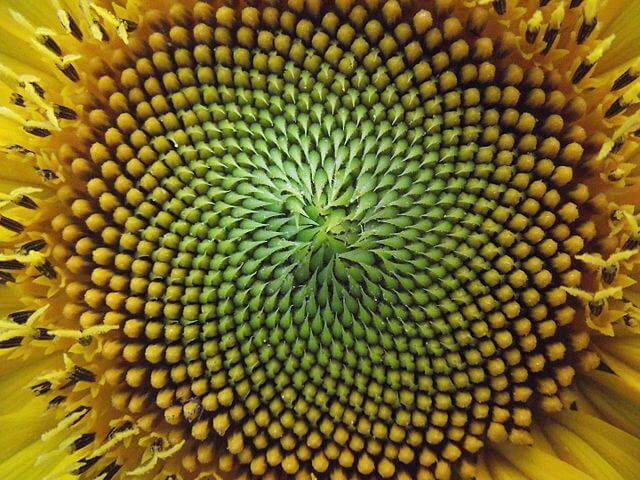Flowers & the Fibonacci Sequence
By Cat Haglund
Broadcast 1999, 2.2002, 5.2016, 5.3 & 5.6.2023

We can see the Fibonacci spiral many times in the nature, both in flora and fauna. This picture is a good example for its appearing in sunflowers. The arrangement of the seeds follows the shape of the spiral with a slight rotation. Photo by Anna Benczur, CC by-SA 4.0.
Listen:
It’s summer, and wildflowers are dotting the hillsides and forests. You might find yourself plucking petals off those flowers, trying to determine if he loves you or she loves you not. If you’re a hopeless romantic who repeats this ritual year after year, you will notice a happy coincidence — more often than not, he or she loves you. This could only mean one thing (besides that you’re worthy of adoration). Empirically speaking, this means that more often than not, flowers have an odd number of petals.
In fact, if you survey a wide range of flowers, you’ll find that not only do the majority have an odd number of petals, but that certain numbers tend to come up more often than others; numbers like 5 and 13. This is no coincidence.
These numbers form a mathematically significant series called the Fibonacci sequence, which is formed by adding two successive numbers to get to the next. In pure mathematics, the sequence starts with 0 and 1, but I’ve never seen a flower with 0 petals, so we can start with the next pair, 1 and 2. Add 1 and 2 to get the next number, 3. Then add 2 and 3 to get 5, add 3 and 5 to get 8, and so on.
The series continues with 13, 21, 34, and 55, which you’ll see a lot if daisies or asters are your flower of choice. Because the sequence starts with one odd and one even number, two-thirds of the numbers will be odd. Try a few with pen and paper if you don’t believe it.
The Fibonacci sequence is named after a 13th-century Italian mathematician who first noticed the pattern while pondering rabbit reproduction rates.
In later centuries, the sequence turned up in studies of musical overtones, spiral shell geometry, and bee genealogy.
But what is the benefit of this distinctive pattern? Well, by packing as many petals, leaves, and seeds into the available space, plants maximize their exposure to the sun. But plants can’t arrange their parts the way we’d pack a box of fruit, starting at one corner and working in rows, left to right. They grow outward from a central point, a tiny cluster of cells at the tip of each growing shoot called the meristem. To complicate matters, the meristem can’t expand in all directions at once. Instead it produces new cells one at a time in a spiral pattern. The new cells grow radially away from the meristem as the meristem grows upward. Think of the thread on a screw and imagine tracing the thread from tip to head, with leaves or petals appearing at equal intervals along the path. But only certain intervals will produce a viable plant.
If a stem put out petals at a rate of one per turn of the screw, all the petals would be lined up on the same side of the flower! The relationship between the number of petals or leaves per turn is often the ratio of two successive Fibonacci numbers. For instance, a willow tree has three leaves for every eight turns.
It’s hard to see the spiral patterns in flowers because of the petals’ thinness. The best way to find the Fibonacci sequence in petals is to pluck them. Try a black-eyed Susan; you’ll see they tend to have 21 petals. Daisies tend to have 34, 55, or 89 depending on the type, so choose a denser one if you want a happy ending to your love story.
Be warned that flowers aren’t precise mathematical machines, so for flowers with many petals, the Fibonacci numbers are only average tendencies. If you want to be certain of your love, you’ll have to stick with reliable 5-petaled wild buttercups, but that would take the mystery out of romance. Why not take your chances with daisies? Remember that nature is on your side.
Every week since 1991, Field Notes has inquired about Montana’s natural history. Field Notes are written by naturalists, students, and listeners about the puzzle-tree bark, eagle talons, woolly aphids, and giant puffballs of Western, Central and Southwestern Montana and aired weekly on Montana Public Radio.
Click here to read and listen to more Field Notes. Field Notes is available as a podcast! Subscribe on Apple Podcasts or wherever you listen to podcasts.
Interested in writing a Field Note? Contact Allison De Jong, Field Notes editor, at adejong [at] montananaturalist [dot] org or 406.327.0405.
Want to learn more about our programs as well as fun natural history facts and seasonal phenology? Sign up for our e-newsletter! You can also become a member and get discounts on our programs as well as free reciprocal admission to 300+ science centers in North America!












